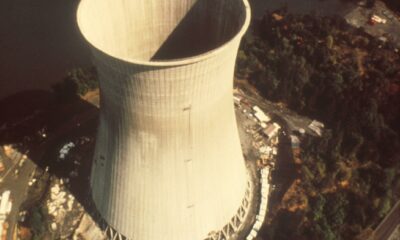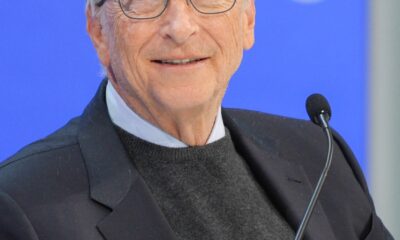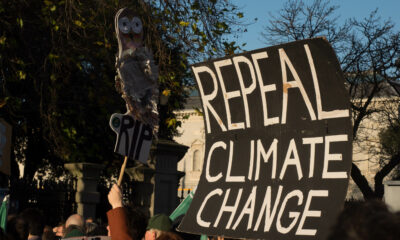Media
Michael Moore warns against his own
Michael Moore recently warned his fellow travelers about several issues they never considered. Happily, solutions to those issues are available.

Recall that CNAV treated the question of how “green” are electric vehicles in April. Now comes confirmation of their most important drawback. And the source confirming it is the last source one might expect: Michael Moore.
Michael Moore comes clean
The new film Planet of the Humans premiered toward the end of July at the Traverse City (Michigan) Film Festival. Michael Moore backed the film and is actively promoting it. Which means he agrees fully with its message.
And that message mortifies the American environmental movement. Simply put, the solutions that movement touts either create more problems than they solve, or solve only half the problem.
Electric vehicles give an example of solving only half the problem. Why? Because their “juice” still comes in large part from fossil fuels. This is especially true in Germany, which abandoned nuclear power. But it also holds in the USA, where coal, oil and natural gas carry the peak load.
Peak load v. base load
Nuclear power carries the base load. A nuclear power plant runs best when it runs at a constant power level. Most nuclear power plants in the world today cannot adjust for fluctuating demand.
To do that, the “grid” on any land mass needs other power plants to carry the peak load. These “peakers” can adjust. As they must, for with every flip of a switch, demand rises or falls. Therefore something or someone must adjust the flow of electricity from all sources. If this does not happen, control circuits overload—and the entire grid can fail.
The problem: coal, oil and natural gas must carry this peak load. Only one nuclear reactor design can adjust as well as they can—the pebble bed modular reactor. Despite its many advantages, no one has even proposed such a reactor in America. One likely reason: not everyone believes it’s safe.
Michael Moore and colleagues identify the basic problem…
So electric vehicles must recharge, and their charging stations are on the grid. Moreover, solar and wind farms also need the grid for backup. And at present, the usual backup is peak-load carriers. Which means fossil fuels, the very fuels Michael Moore loves to hate.
Not that he lacks good reason. Fossil fuels, except possibly for natural gas, pollute the atmosphere wherever one burns them. They release ultra-fine particles, carbon monoxide, nitrogen oxides, and “aromatic hydrocarbons” (like benzene and its derivatives). And these substances poison anyone near the engines that burn them, chronically or acutely.
Regular readers will remember that CNAV mentioned one way to solve that problem: big batteries. But Michael Moore doesn’t mention them. For that only one reason suggests itself. Michael Moore doesn’t mention big batteries because too few utility providers are building or ordering them. He and his colleague don’t think about them because they don’t see them.
…and other problems
But the problems don’t stop with these peak-load power plants. Director Jeff Gibbs highlighted “biomass,” for example. Instead of burning something you dig out of the ground, burn something you grow today. Sounds reasonable—until you remember how many trees you must cut down to satisfy the demand. Michael Moore and Jeff Gibbs mentioned only the cutting-down of trees as bad enough. But they did not mention the energy one expends in that cutting-down, by the lumberjacks and in the sawmills. That would make the case against biomass even stronger. But they do raise a point more damning still. None of the environmental activists with whom they spoke even wanted to talk about these problems!
So what do we do about this?
In an interview with Channel 17 in western Michigan, Michael Moore admitted one failing of Planet of the Humans. The new film “doesn’t have the answers.” That could be because the film already took long enough to describe the problem.
For a Michael Moore to talk about these problems willingly is a great and pleasant surprise. This holds especially since The Squad1 in the U.S. House of Representatives will not talk about them.
Michael Moore is no longer anti-nuclear
Nor
is this the first time Michael Moore has said something other
environmentalists would call anathema. Six years ago, in the film
Pandora’s
Promise, he urged a second
look at nuclear power.
The film makes two points:
- Though so many are afraid of nuclear reactors, they now hold the best promise to stop a worse problem. (Carbon dioxide isn’t the problem, but those other emissions definitely are.)
- More and more activists have rethought their attitude toward nuclear power of late, and have re-embraced it.
Other pro-nuclear voices
This list shows many, including Moore, who have at least said they embrace nuclear energy. One cannot necessarily trust the politicians in that list. (Politicians are as changeable as mercury and almost as toxic.) But one can definitely trust the scientists and engineers. Among them: James Hansen, PhD, the American counterpart to Phil Jones of the British Climatic Research Unit. Said he in a letter to Obama Science Adviser John Holdren, before COP-21 in Paris:
The danger is that the minority of vehement antinuclear “environmentalists” could cause development of advanced safe nuclear power to be slowed such that utilities are forced to continue coal-burning in order to keep the lights on. That is a prescription for disaster.
And that speaks volumes. A minority of environmentalists, he says? If true, America could solve its pollution problem faster than we think—and likely save vast sums while doing it. (Sorry, Squad.)
Enter Elon Musk
Elon Musk, at Tesla, struck a blow last year for the other solution to the fossil-fuels problem. He approached the electrical authority in South Australia. They were desperate for a solution to the problem of how to handle excess solar and wind power. So Musk told them: let me build for you the biggest battery in the world. If I can’t get it done in 100 days, you can have it free of charge.
He did it within the hundred days. Within a year the big battery proved its worth. In fact it has reduced the cost of servicing South Australia’s grid by ninety percent.
So now Musk has released his latest product, the Megapack. This three-MWh module comes with its own inverters, coolers, AC circuit breaker, and controls. Compared to Musk’s original South Australia project, a Megapack project can go up ten times faster. The Megapack already has an American customer: Pacific Gas and Electric, in southern California.
What can this new product do?
Here the Tesla company describes what a Megapack array can do:
Using Megapack, Tesla can deploy an emissions-free 250 MW, 1 GWh power plant in less than three months on a three-acre footprint – four times faster than a traditional fossil fuel power plant of that size. Megapack can also be DC-connected directly to solar, creating seamless renewable energy plants.
In short, Musk proposes using these batteries instead of peak-load power plants. An engineer can readily see how that would work:
- Install a number of Megapack arrays, each capable of delivering as much power as a fossil-fueled peak loader.
- Ramp up the output of local nuclear generators. This higher base load will charge the Megapacks at night so they can deliver the peak load the next day.
- Decommission the peak loaders as the grid can get along without them.
For “renewables” also
At the same time, Musk proposes to equip solar and wind farms with their own Megapack arrays. Then these farms can deliver “smooth” power to the grid, and still adjust their output with demand.
This last is vital, because South Australia’s problems began with excess solar capacity by day. Anyone familiar with ground-based solar energy knows about the “Duck Curve.” The net of excess supply (or unsatisfied demand) over time shows great excess at local noon, then unsatisfied demand near local sunset. The resulting curve looks like the profile of a duck; hence its name.
But with a battery array, a solar farm can recharge during the off-peak hours of the day. Then it can respond as smoothly as can any peak-load provider to increased demand.
Finding the land
Allowing nuclear power to stay in the mix, relieves one big problem: where to find the land. Ground-based solar and wind power take up a lot of land. Not as much as a hydroelectric dam, but five or six times as much per kilowatt as any power plant today.
Elon Musk has declined to develop space-based solar energy. Collecting the sun’s rays in space requires three conversion steps:
- Solar to electrical,
- Electrical to microwave, and
- Microwave to electrical.
Musk estimates only ten percent efficiency at the end of that process. So one would need to collect ten times as much sunlight for the energy it could deliver on the ground. Perhaps Musk worries that such large satellites would cost far too much, in building, lofting into space, re-assembly, and upkeep. And he might very well be correct.
Replacing all that energy
But the efficiency of electric vehicles turns out to be significant. EPA “miles-per-gallon-equivalent” ratings show that electric vehicles can be four times as efficient as their internal-combustion enegine counterparts. So driving an electric vehicle today takes as much as seventy-five percent less energy. That translates to seventy-five percent lower extra demand, and seventy-five percent less pollution from current sources.
So if Michael Moore fears that electric vehicles cannot be part of the solution, he can relax. Reducing pollution by seventy-five percent is better than not reducing it at all. The only problem is that electric vehicles shift their pollution to a poor neighborhood, or to an industrial district. But now the electric utility can easily replace its peak-load generators with battery arrays. Nuclear generators and even ground-based solar farms can then take up the load. And that will eliminate the twenty-five percent of pollution that remains.
Conclusion
Michael Moore, as he admitted, doesn’t have the answer. But he has forthrightly, and correctly, identified the problem. The answers he leaves to others—but others have already found the answers.
1 The members of The Squad, as of today, are Representatives Alexandria Ocasio-Cortez (D-N.Y.), Rashida Tlaib (D-Mich.), Ilhan Omar (D-Minn.), and Ayanna Pressley (D-Mass.).
About the image
This portrait of Michael Moore by Andrew McFarlane is licensed under CC BY 2.0
Terry A. Hurlbut has been a student of politics, philosophy, and science for more than 35 years. He is a graduate of Yale College and has served as a physician-level laboratory administrator in a 250-bed community hospital. He also is a serious student of the Bible, is conversant in its two primary original languages, and has followed the creation-science movement closely since 1993.
-

 Civilization2 days ago
Civilization2 days agoDC Pipe Bomb Arrest Raises Questions About Christopher’s Wray’s FBI
-

 Civilization5 days ago
Civilization5 days agoYoo Hoo, VP Vance—Your Character is Showing!
-

 Executive5 days ago
Executive5 days agoThe Last Supper: New York’s Socialist Feast
-

 Guest Columns4 days ago
Guest Columns4 days agoCongressional Leaders See Far Higher Stock Returns Than Peers
-

 Civilization3 days ago
Civilization3 days agoThe Legal Logic Behind U.S. Operations Against Narco-Terrorist Networks
-

 Civilization5 days ago
Civilization5 days agoFacing Facts & Rolling Back Mythologies: The New National Security Strategy
-

 Civilization4 days ago
Civilization4 days agoHow Trump Changed America
-

 Executive3 days ago
Executive3 days agoNewsom’s ‘National Model’ for Homeless Wracked by Fraud














